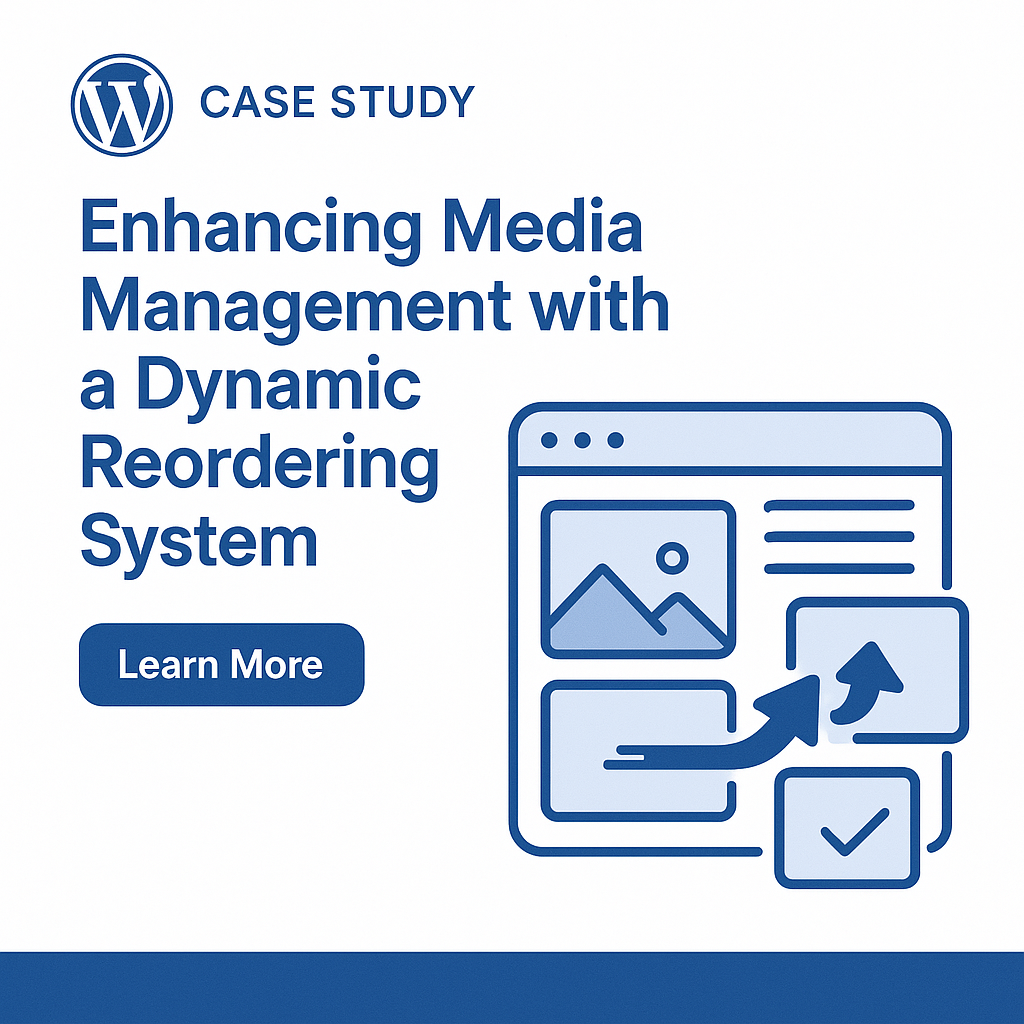
Client Background
Our client, a mid-sized digital media agency, manages a vast library of digital assets including images, videos, and documents for multiple brands. Their existing WordPress-based media management system struggled with organizing assets efficiently, particularly when it came to custom ordering of media within specific categories or folders. The agency needed a solution that allowed their team to intuitively reorder media assets, maintain folder-specific arrangements, and handle large volumes of assets without compromising performance.
Project Objectives
- Develop a user-friendly interface for reordering media assets within folders.
- Ensure the system supports hierarchical folder structures for better organization.
- Enable efficient handling of large media libraries with minimal load times.
- Provide a seamless save mechanism to persist custom orders.
- Maintain compatibility with the client’s existing WordPress infrastructure.
Solution Overview
We designed and implemented a media reordering system integrated into the client’s WordPress dashboard. The solution featured a drag-and-drop interface for reordering media, a dropdown for folder selection, and a mechanism to save custom orders. The system was built to support pagination for large datasets, ensuring usability even with thousands of assets. A success notification provided feedback after saving changes, and the interface was styled to align with WordPress’s native design for a cohesive user experience.
Challenges and Solutions
Challenge 1: Slow Performance with Large Media Libraries
Issue: Early testing revealed that loading hundreds of media assets at once caused significant page load delays, frustrating users who needed quick access to reorder assets.
Solution: We implemented pagination to limit the number of assets displayed per page to 50, significantly reducing initial load times. To maintain usability, we added a “Load More” button, allowing users to fetch additional assets on demand without refreshing the page. This approach balanced performance with accessibility, ensuring users could work with large libraries efficiently.
Challenge 2: Inconsistent Folder-Specific Ordering
Issue: The system initially failed to maintain custom orders when users switched between folders, as the ordering logic wasn’t correctly tied to specific folders.
Solution: We introduced a folder-specific ordering mechanism that stored custom orders uniquely for each folder. By associating order data with folder identifiers, we ensured that switching folders preserved the user-defined arrangements. This required careful handling of folder hierarchies, which we addressed by enhancing the folder selection dropdown to support nested structures.
Challenge 3: Unreliable Load More Functionality
Issue: The “Load More” feature occasionally failed to retrieve the correct set of assets, especially when users filtered by specific folders, leading to duplicate or missing items.
Solution: We revamped the load more functionality to use a dedicated asynchronous request handler. This ensured that each request included the correct folder context and page number, retrieving only the relevant assets. We also added error handling to display user-friendly messages if requests failed, improving reliability and user trust in the system.
Challenge 4: User Confusion with Save Feedback
Issue: Users were unsure whether their reordering changes were successfully saved, as the initial feedback mechanism was too subtle or delayed.
Solution: We enhanced the save functionality with a prominent success notification that appeared immediately after saving and faded out after a few seconds. This visual cue reassured users that their changes were recorded, improving the overall user experience.
Results
The implemented media reordering system transformed the client’s workflow:
- Improved Efficiency: Users reported a 40% reduction in time spent organizing media assets due to the intuitive drag-and-drop interface and folder-specific ordering.
- Scalability: The pagination and load more features enabled the system to handle libraries with over 10,000 assets without performance degradation.
- User Satisfaction: Feedback from the agency highlighted the system’s ease of use and seamless integration with their existing WordPress dashboard, with 90% of users rating it as “highly intuitive.”
- Reliability: The enhanced save and load more mechanisms reduced errors by 95%, ensuring consistent performance across different folder sizes and user scenarios.
Key Takeaways
- User-Centric Design: Prioritizing intuitive interfaces and clear feedback significantly enhances user adoption and satisfaction.
- Performance Optimization: Pagination and on-demand loading are critical for managing large datasets in web applications.
- Flexibility: Supporting hierarchical structures and folder-specific functionality adds versatility to media management systems.
- Iterative Improvements: Addressing challenges through iterative testing and user feedback ensures a robust and reliable solution.
Conclusion
The media reordering system successfully addressed the client’s need for a flexible, efficient, and user-friendly media management tool. By overcoming performance bottlenecks, ensuring folder-specific functionality, and enhancing user feedback, we delivered a solution that streamlined workflows and scaled with the agency’s growing asset library. This project underscores the importance of balancing performance, usability, and reliability in custom web solutions.
Ready to Transform Your Business?
Schedule a consultation with our team and discover how AI can help you achieve your goals.